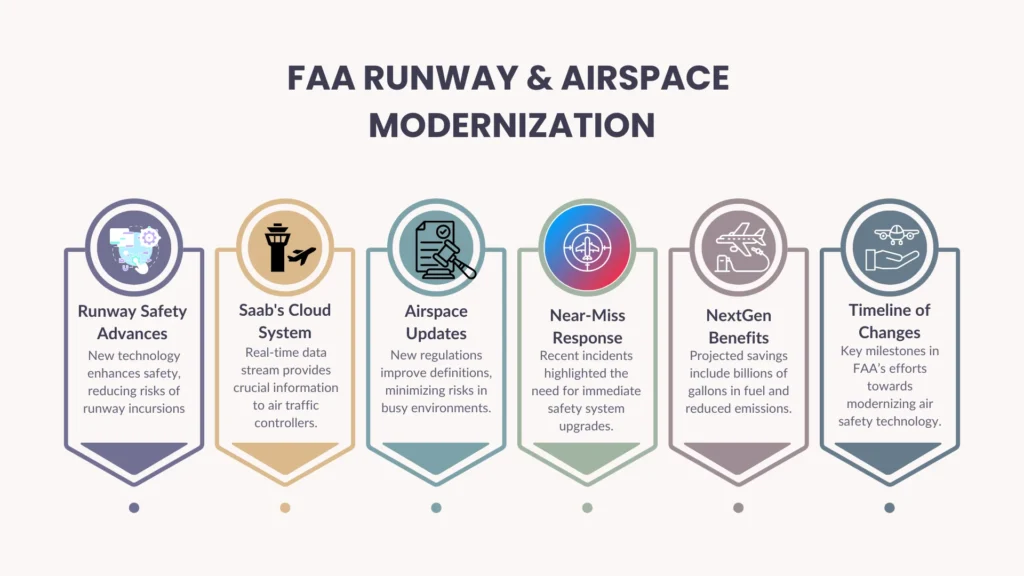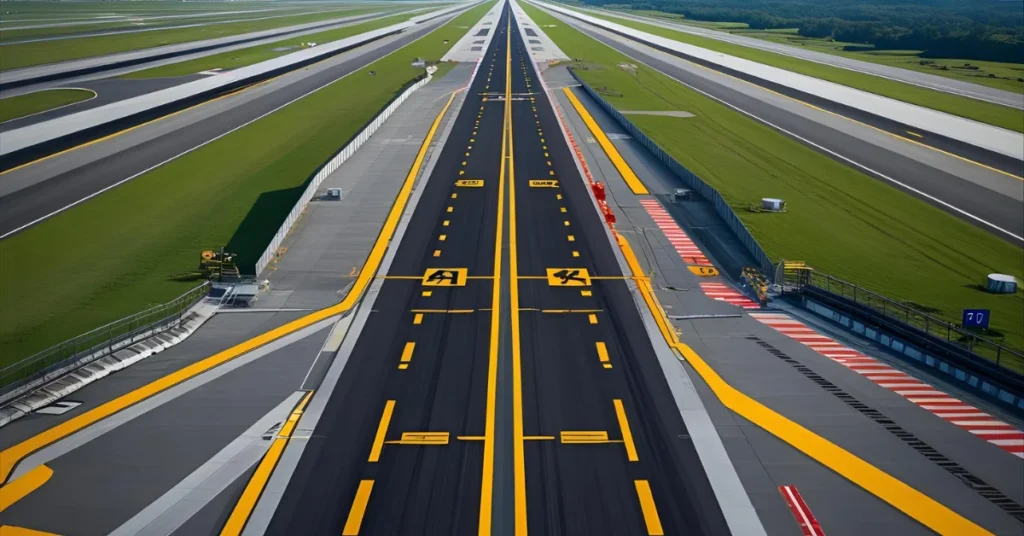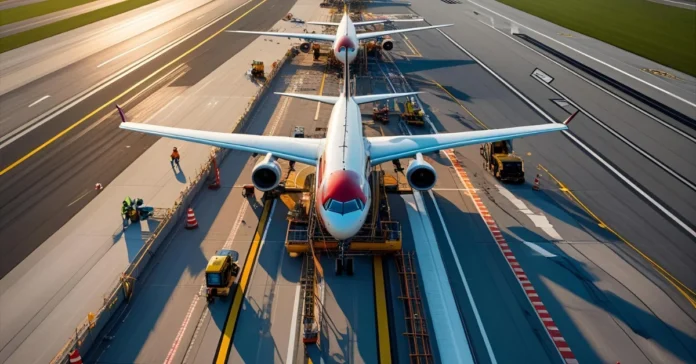Overview
FAA Air Safety Improvements: Starting in June 2025, the Federal Aviation Administration (FAA) is making significant changes to improve air safety in the United States.
These efforts include upgrading runway safety and adjusting airspace classifications as part of a broader initiative called the NextGen modernization program.
This plan aims to make U.S. air travel not only safer but also more efficient. The FAA’s commitment to these upgrades marks a crucial step toward enhancing the safety of air traffic for both passengers and crew.
Runway Safety: The Saab Aerobahn Initiative
What’s Rolling Out
On June 25, the FAA approved the Saab Aerobahn Runway & Surface Safety (RAAS) system to be used at 26 additional airports across the United States.
This cutting-edge, cloud-based system aims to significantly reduce risks associated with runway operations.
How It Works
The Saab Aerobahn system combines several advanced technologies, including surface tracking, cooperative Automatic Dependent Surveillance-Broadcast (ADS-B) sensors, and cloud analytics.
Together, these tools provide air traffic controllers (ATC) with real-time information about runway conditions.
This proactive approach helps to prevent dangerous situations like runway incursions (when an aircraft mistakenly enters a runway) and misalignments.
Remarkably, the system can be fully operational in just 90 days, making it a swift solution for enhancing runway safety.
FAA & Saab Partnership
The collaboration between the FAA and Saab spans over 30 years, showcasing a long-standing commitment to improving aviation safety.
Erik Smith, the President & CEO of Saab US, emphasized that this new system is not only cost-effective but also significantly enhances safety for both air traffic controllers and passengers.
Airspace Classification: Fine-Tuning for Safety
June 27 Federal Register Notice
On June 27, the FAA proposed amendments to the regulations governing Class D and Class E controlled airspace surrounding Indiana’s Elkhart and Goshen Municipal Airports.
This update is designed to improve Instrument Flight Rules (IFR) operations and streamline how airspace is managed.
Why It Matters
These amendments are crucial because they refine how altitudes and boundaries are defined, which helps to minimize potential conflicts between different types of air traffic.
This improvement is especially vital for regional airports that are experiencing growth, as it ensures that both IFR (which relies on instruments for navigation) and Visual Flight Rules (VFR, which rely on visual cues) can operate safely without interfering with each other.
Broader Context: NextGen Modernization
Technology Underpinnings
The NextGen program is a significant technological initiative that includes various components designed to enhance air travel.
Since January 2020, the deployment of ADS-B technology has been mandated nationwide, adding advanced capabilities to air traffic management.
Other components of NextGen include the replacement of outdated systems, Data Communications, remote towers, System Wide Information Management (SWIM), and trajectory-based operations.
These innovations aim to save fuel, reduce emissions, and improve overall flight safety, creating a more efficient airspace system.
Safety Gains
The NextGen program has already demonstrated notable safety improvements. For instance, the introduction of runway verification alerts in tools like the Standard Terminal Automation Replacement System (STARS) has proven effective.
At airports like Minneapolis-St. Paul, the number of go-around events (when a pilot must abort a landing and circle back to the airport) dropped by 23%.
This reduction not only enhances safety but also saves time and fuel during flights.
Quantified Benefits
By the year 2030, the NextGen program is expected to bring remarkable benefits. It is projected to eliminate approximately 2.8 billion gallons of fuel, cut carbon dioxide (CO₂) emissions by around 650 million tons, and create over $12.3 billion in benefits by 2024.
These figures highlight the program’s positive impact on both safety and the environment.
Safety & Incident Triggers

High-Risk History
Airports worldwide have faced numerous near-misses and runway incursions. A recent case occurred in December 2024 in Jacksonville, where there were reports of aircraft landing on the wrong runway, emphasizing the need for urgent safety improvements across the aviation industry.
FAA Incidents Prompting Action
Concerns over safety were further heightened after a near miss in 2025, involving an Army helicopter and an American Airlines jet near Reagan National Airport.
This incident reinforced the FAA’s momentum for implementing surface-system upgrades to prevent similar occurrences in the future.
NOTAM Overhaul
In April, the FAA took steps to modernize the Notices to Air Missions (NOTAM) system, which provides essential information to pilots regarding temporary flight restrictions.
This modernization aims to transition to real-time digital distribution, making important updates more accessible and efficient.
Implementation & Hurdles
Rapid Deployment
One of the standout features of Saab’s runway safety solution is its rapid deployment capability. With a 90-day installation timeframe, this system leverages the advanced ADS-B sensors already integrated into the U.S. NextGen network, allowing for quick and efficient updates to safety protocols.
Funding & Complexity
The United States has invested over $14 billion in aviation modernization; however, several challenges remain.
Delays, fragmented funding strategies, and the complexity of managing multiple systems often slow progress. These challenges indicate the need for continued focus and solutions to streamline the upgrade process.
Standardization Pressure
The FAA issues around four million NOTAMs annually, highlighting the importance of streamlining these alerts to prevent overwhelming pilots with information.
Simplifying communications is vital to ensure that critical safety messages are effectively conveyed without causing confusion.
The Way Forward
Safety First
By introducing runway alerts and enhancing airspace classifications, the FAA is strengthening safety measures both on the ground and in the air.
This commitment showcases a serious dedication to reducing incursions, improving clarity, and ensuring the safety of air travel for everyone involved.
Efficiency & Climate Gains
The improvements in air traffic management will lead to cleaner taxi routes, smoother climbs and descents, and more efficient route planning.
These changes are expected to result in lower fuel consumption, fewer emissions, and shorter travel times for flights.
Modernization Continues
The FAA’s NextGen program is progressing steadily toward its goals for 2030. The ongoing improvements in safety systems, enhanced traffic data sharing, and the design of regenerative airspace are all contributing to a safer and more efficient flying environment.
Conclusion
The International Air Transport Association (IATA) and Sustainable Aviation Fuel (SAF) initiatives play crucial roles in the ongoing effort to reduce the environmental impact of air travel.

Stronger policies on SAF—like mandates, subsidies, and international cooperation—are essential for achieving decarbonization in aviation.
While the progress made so far is promising, it is vital to continue pushing for swift and strategic actions to reach meaningful goals.
In terms of FAA’s runway and airspace improvements, by implementing Saab’s technology and refining airspace definitions, the FAA is taking significant steps toward creating a safer, cleaner, and more efficient National Airspace System.
These upgrades are aligned with both operational needs and environmental challenges, ensuring that air travel continues to evolve responsibly.
Frequently Asked Questions (FAQs)
- What is the FAA’s NextGen modernization program?
- The FAA’s NextGen program aims to modernize the U.S. airspace system to improve safety, efficiency, and environmental sustainability through advanced technologies.
- How does the Saab Aerobahn system enhance runway safety?
- The Saab Aerobahn system uses real-time data from advanced sensors to alert air traffic controllers about runway conditions, helping to prevent accidents and misalignments.
- What are the recent changes to airspace classification?
- The FAA proposed amendments to define altitude and boundaries more clearly around certain airports, reducing conflict risks between different flight rules, especially in busy regional airports.
- What steps is the FAA taking to address near-miss incidents?
- In response to recent near-miss incidents, the FAA is implementing new technologies for runway safety and updating the NOTAM system to improve real-time communication for pilots.
- How will NextGen benefit the environment?
- NextGen is expected to save billions of gallons of fuel and significantly reduce carbon emissions, making air travel more environmentally friendly through enhanced efficiency

